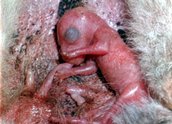
Birth of the Red Kangaroo (1965)
Synopsis
This CSIRO documentary details the reproductive cycle of the red kangaroo, its mating habits and the early stages of a kangaroo’s development as it grows in the pouch. It includes animated diagrams to illustrate the gestation period, egg fertilisation and development, complemented by close-up shots of a live birth, a newly-born embryo and the young joey’s development in the pouch.
Curator’s notes
This is a fascinating film about marsupial reproduction, not just from an educational and scientific point of view, but from a filmmaking perspective as well. It was filmed on 16mm by the CSIRO Film Unit and the Division of Wildlife Research. Its purpose was to show the unusual ways in which marsupials develop.
By using scientific studies on captive red kangaroos, it debunks the myths and legends which had informed theories of kangaroo birth in the past. It illustrates the valuable contribution that filmmaking can make to science, as a tool for research as well as education. In 1628, for example, Dutch merchant Francisco Pelsaert ran aground on the west coast of Australia. He subsequently observed the Tammar wallaby and proposed that their young were born inside the pouch from the teat and remained there until they were able to walk. According to the film, it was scientific research that put such myths to rest.
The camera captures some extraordinary scenes in intimate detail from what would appear to be impossibly close angles. There is a shot of a tiny new-born embryo as it climbs up its mother’s fur to the pouch and, in clip one, the kangaroo’s pouch is held open so the camera can film the young inside.
Kangaroos remain a popular subject for filmmakers. Two documentaries to screen on ABC TV in recent years are Kangaroos: Faces in the Mob (2007), which also included footage of the birth of a joey, and Kangaroo Mob (2011).
Birth of the Red Kangaroo was highly acclaimed in scientific circles and screened internationally. It won the Orbit Award at the ANZAAS Exhibition in 1966, the Grand Prize for Scientific and Technical Films at the Brussels Film Festival in 1967, a Silver Award in the Teaching and Educational category at the 1966 Australian Film Awards and the Blue Ribbon Award at the American Film Festival in New York in 1969.
- Overview
- Curator’s notes
- Video 1 clip
- Principal credits
- Find a copy
- Make a comment
- Add your review



